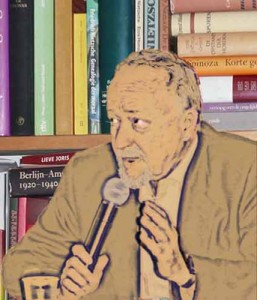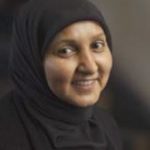Minder ernstig – Vaker gestraft – Een onderzoek naar de aard en kwalificatie van jeugdcriminaliteit
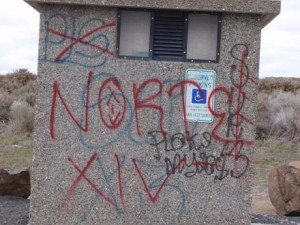 Dit onderzoek is uitgevoerd door het Bonger Instituut voor Criminologie i.s.m. de leerstoel-groep Strafrechtwetenschappen, Faculteit der Rechtsgeleerdheid van de Universiteit van Amsterdam, in opdracht van het Wetenschappelijk Onderzoek- en Documentatiecentrum (WODC) van het ministerie van Veiligheid en Justitie. Rozenberg Publishers 2012. ISBN 978 90 361 0299 5
Dit onderzoek is uitgevoerd door het Bonger Instituut voor Criminologie i.s.m. de leerstoel-groep Strafrechtwetenschappen, Faculteit der Rechtsgeleerdheid van de Universiteit van Amsterdam, in opdracht van het Wetenschappelijk Onderzoek- en Documentatiecentrum (WODC) van het ministerie van Veiligheid en Justitie. Rozenberg Publishers 2012. ISBN 978 90 361 0299 5
m.m.v. Jennifer Doekhie, Marijn Everartz en Niels Büller
Begeleidingscommissie
Dr. Jan Nijboer (voorzitter) – Rijksuniversiteit Groningen, Faculteit der Rechtsgeleerdheid
Drs. Essy van Dijk – Ministerie van Veiligheid en Justitie, WODC
Mr. Janine Berton – Arrondissementsparket Den Haag
Drs. Gert-Jan Terlouw − Ministerie van Veiligheid en Justitie, Directie Justitieel Jeugdbeleid
Drs. Peter Versteegh – Politie Haaglanden
Universiteit van Amsterdam
Bonger Instituut voor Criminologie www.bonger.nl
Ministerie van Veiligheid en Justitie Wetenschappelijk Onderzoek- en Documentatiecentrum (WODC) www.wodc.nl
Inhoudsopgave
1. Inleiding
– Nederlandse trends in officiële cijfers over jeugdcriminaliteit
– Verklaringen voor trends in officiële criminaliteitscijfers
– De rol van media
– Inflatie van geweld
– Ontwikkelingen in het (jeugd)strafrecht
– Doelstelling, probleemstelling en onderzoeksvragen en hypothesen
– Begrippen
– Opzet in grote lijnen
2. Methode
– Steekproef
– Checklist
– Verloop dossieronderzoek
– Dossiers, incidenten, feiten, checklists en synopsissen
– Vignetten
– Aanvullende steekproef
– Statistische analyse
– Focusgroep
3. Verdachten
– Leeftijd
– Geslacht
– Etnische achtergrond en nationaliteit
– Woonsituatie
– School en werk Read more
Designing A City From The Bottom Up: Jared Sacks & Nobanzi Dlodlo at TEDxCapeTown City2.0
Jared Sacks: Social Activist
Nobanzi Dlodlo: Mother of three, community leader
Full title: Poor people are the experts of their own oppressive conditions
The philosophy behind TED talks posits that we need professionals; consultants and other experts have the answers to the worlds’ problems. This talk, however, proposes that the key predicaments of modern society such as poverty, inequality and oppression, can only be solved by those who live every single day on the receiving end of this structural violence. Nobanzi and Jared believe strongly in the ability of people to collectively initiate and direct their own solutions rather than them relying on others for leadership and expertise. People are the experts of their own oppression and visitors can only begin to glimpse the possibilities of a new world if they are willing to listen to the words of the poor.
Jared Sacks was born in Johannesburg and went to university at UC-Berkeley. Since 2007, he has been living in Cape Town working directly with communities supporting their efforts to build authentic grassroots social change. He has worked closely with a range of poor people’s social movements including Abahlali baseMjondolo, the Western Cape Anti-Eviction Campaign, and the Landless People’s Movement. He is the compiler and supporting editor of the anthology No Land! No House! No Vote! Voices from Symphony Way which provides unique insight into the views and actions of one of South Africa’s moves significant intentional communities.
Nobanzi Dlodlo is a single mother of three from the Eastern Cape who moved to Cape Town so that she could find a job to support her children. Even though she could not find a job, she remains the only breadwinner for her children by making ends meet through odd jobs and informal business. She volunteered to be an elected member of Sweet Home sack settlement’s committee because this is one of the ways she is able to improve the lives of her children and her neighbours.
In the spirit of ideas worth spreading, TEDx is a program of local, self-organized events that bring people together to share a TED-like experience. At a TEDx event, TEDTalks video and live speakers combine to spark deep discussion and connection in a small group. These local, self-organized events are branded TEDx, where x = independently organized TED event. The TED Conference provides general guidance for the TEDx program, but individual TEDx events are self-organized.* (*Subject to certain rules and regulations)
Bamanya: Un Livre Dans La Forêt
Si tu tires une croix diagonale sur une carte moderne du monde, tu verras que Mbandaka se trouve au centre. Stanley érigeait ici en 1883, un “outpost of progress” sous le nom d“Equator Station”. Maintenant, Mbandaka (Coquilhatville jusqu’en 1966) est une des plus grandes villes du Congo, avec entre l00.000 et 150.000 habitants. Le bourg à la rive de cette grande rivière, le Congo, est pauvre; il y a peu ou pas d’industrie.
Dans le centre, les traces de l’époque coloniale sont encore visibles. Le long des larges rues, on trouve les ruines, ou les restes des pillages successifs, des jolies maisons au style colonial.
Plus de quarante ans de déclin n’ont laissé rien d’entier.
La ville est la capitale de la Province de l’Equateur. Le territoire, deux, trois fois les Pays-Bas, évoque dans le reste du Congo un sentiment compatissant: c’est le pays des chasseurs et des pêcheurs.
Dix kilomètres de Mbandaka se trouve le village de la mission de Bamanya. La piste de sable qui y mène est caractérisée par les légendaires nids de poules qui mettent homme et véhicule à dure épreuve.
Le premier matin de mon séjour, je suis éveillé par des chansons. Une centaine de voix jubilantes d’enfants fait fonction de réveil. Ce sont les enfants de l’école de la Mission qui en guise de gymnastique marchent en galop vers la bourgade voisine. Il est sept heures et demi. Je prends une douche froide, et pendant que je m’habille, la sueur gicle de ma tête.
Les cent cinquante abonnées des Annales Aequatoria doivent patienter: Les plaques d’aluminium pour l’imprimerie à Kinshasa se trouvent depuis des mois à Matadi, la ville portuaire du Congo et attendent le dédouanement. C’est un des multiples problèmes contre lesquelles on a à se battre dans ce pays quand on veut entreprendre quelques chose. “C’est l’Afrique” est l’argument sans réplique.
L’annuaire est publié par le Centre Aequataria, Centre de recherches Culturelles Africanistes. Le Centre possède une bibliothèque avec environ 8.000 livres et 300 titres de périodiques. Des archives linguistiques et historiques (locales) complètent cette documentation spécialisée. Read more
Jenny Morgan – A Place In The City (2008)
Journeyman Pictures: Place in the City (2008): Inside the struggle of South Africa’s post-apartheid shack dwellers. The South African Shack Dwellers Trying to Find a Voice.
Coffeeshops, bezoekersstromen, motieven voor bezoek en spreiding in Amsterdam
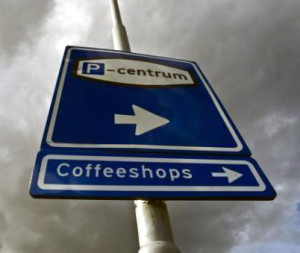 Dit onderzoek is uitgevoerd door het Bonger Instituut voor Criminologie van de Universiteit van Amsterdam, in opdracht van de Directie Openbare Orde en Veiligheid van de Gemeente Amsterdam. Met medewerking van: Shima Asadi, Julianne Jansen & Raoul Profijt. Rozenberg Publishers 2010. ISBN 978 90 3610 203 2
Dit onderzoek is uitgevoerd door het Bonger Instituut voor Criminologie van de Universiteit van Amsterdam, in opdracht van de Directie Openbare Orde en Veiligheid van de Gemeente Amsterdam. Met medewerking van: Shima Asadi, Julianne Jansen & Raoul Profijt. Rozenberg Publishers 2010. ISBN 978 90 3610 203 2
Inhoudsopgave
– Inleiding – Context: Landelijk en Amsterdams coffeeshopbeleid | Achtergrond, doel en onderzoeksaanpak
– Onderzochte coffeeshops in West en Oost – Bezoekersstromen | Profiel | Motieven voor bezoek | Bereikbaarheid en overlast
– Coffeeshopbezoekers in West en Oost – Respons en representativiteit | Bezoekersprofiel | Coffeeshopbezoek | Favoriete coffeeshop en woonbuurt | Afstand tot coffeeshop | Coffeeshop in de eigen woonbuurt | Criteria voor coffeeshopbezoek
– Stevige blowers in en rond Amsterdam – Profiel | Coffeeshopbezoek | Waar naar de coffeeshop? | Coffeeshop in de eigen woonbuurt | Criteria voor coffeeshopbezoek
– Samenvatting en conclusie – Bezoekersstromen | Motieven voor coffeeshopbezoek | Criteria voor spreiding
Literatuur
Coffeeshops, bezoekersstromen, motieven voor bezoek en spreiding in Amsterdam ~ Inleiding
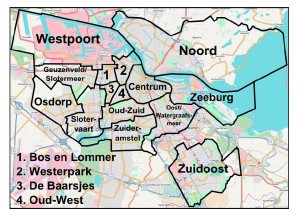 Een deel van de Amsterdamse coffeeshops trekt relatief veel bezoekers vanuit andere buurten c.q. stadsdelen. Dit thema speelt mee in de discussies over (de wens tot) een meer evenwichtige spreiding van coffeeshops over de stad. Daarbij is een belangrijk gegeven dat sinds 1 mei 2010 het aantal stadsdelen door samenvoeging is verminderd van twaalf naar zeven.
Een deel van de Amsterdamse coffeeshops trekt relatief veel bezoekers vanuit andere buurten c.q. stadsdelen. Dit thema speelt mee in de discussies over (de wens tot) een meer evenwichtige spreiding van coffeeshops over de stad. Daarbij is een belangrijk gegeven dat sinds 1 mei 2010 het aantal stadsdelen door samenvoeging is verminderd van twaalf naar zeven.
* De stadsdelen Centrum, Noord en Zuidoost zijn ongewijzigd.
* Oost omvat Oost-Watergraafsmeer en Zeeburg.
* West bestaat uit de voormalige stadsdelen Bos en Lommer, De Baarsjes, Oud-West en Westerpark.
* Nieuw-West is een samenvoeging van Osdorp, Slotervaart en Geuzenveld-Slotermeer
Met ruim 200 van de circa 700 coffeeshops heeft Amsterdam de hoogste coffeeshop-dichtheid van Nederland.[i] Coffeeshops zijn onevenwichtig gespreid over de stad, een fenomeen dat niet geheel los gezien kan worden van de functies van stadsdelen c.q. buurten. Binnen Amsterdam is ongeveer de helft van de coffeeshops gevestigd in het Centrum. Deze coffeeshops trekken veel bezoekers van buiten het stadsdeel, naast (buitenlandse) toeristen ook veel uitgaanders. Andere gebieden met veel coffeeshops zijn de voormalige stadsdelen Oud-Zuid, De Baarsjes, Oud-West en Westerpark.
Daarentegen zijn er heel weinig coffeeshops in bijvoorbeeld het voormalige stadsdeel Osdorp, terwijl Zuidoost helemaal geen coffeeshop heeft.
Ook binnen de (voormalige) stadsdelen met relatief veel coffeeshops zijn er concentratiegebieden, zoals het Wallengebied in Centrum, De Pijp in Oud-Zuid en rond het Mercatorplein in De Baarsjes. Maar ook in een stadsdeel met slechts een paar coffeeshops kunnen ze dicht bij elkaar liggen, bijvoorbeeld in het voormalige Zeeburg (nu onderdeel van stadsdeel Oost).
Context: Landelijk en Amsterdams coffeeshopbeleid
De laatste jaren is er het nodige veranderd in het coffeeshopbeleid. De wens om landelijk het aantal coffeeshops terug te dringen heeft sinds midden jaren negentig geleid tot een halvering. Ook in Amsterdam is het aantal coffeeshops flink teruggelopen, onder andere door sluiting na overtreding van de AHOJG criteria en als gevolg van het feit dat ‘natte’ coffeeshops moesten kiezen tussen het schenken van alcohol of de verkoop van cannabis. Daarnaast werd in 1996 onder andere de minimumleeftijd voor bezoekers verhoogd van 16 naar 18 jaar. Sinds 1 juli 2008 mag er (net als in andere horecagelegenheden) geen tabak meer gerookt worden in coffeeshops, ook geen joints met tabak. (In Nederland wordt cannabis in verreweg de meeste gevallen gerookt, in de vorm hasj of wiet vermengd met tabak in een joint). Ten slotte deed de toenmalige minister van VWS (Klink) namens de regering in vervolg op het rapport van de commissie Van de Donk (2009) een aantal voorstellen tot aanpassing van het coffeeshopbeleid, waaronder schaalverkleining van coffeeshops. (“De coffeeshop dient uiteindelijk weer een klein etablissement te worden.”)[ii] Read more


